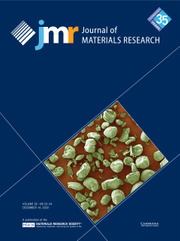Article contents
Atomic structure of YB56 studied by digital high-resolution electron microscopy and electron diffraction
Published online by Cambridge University Press: 31 January 2011
Abstract
Atomic positions for Y atoms were determined by using high-resolution electron microscopy and electron diffraction. A slow-scan charge-coupled device camera which had high linearity and electron sensitivity was used to record high-resolution images and electron diffraction patterns digitally. Crystallographic image processing was applied for image analysis, which provided more accurate, averaged Y atom positions. In addition, atomic disordering positions in YB56 were detected from the differential images between observed and simulated images based on x-ray data, which were B24 clusters around the Y-holes. The present work indicates that the structure analysis combined with digital high-resolution electron microscopy, electron diffraction, and differential images is useful for the evaluation of atomic positions and disordering in the boron-based crystals.
Information
- Type
- Articles
- Information
- Copyright
- Copyright © Materials Research Society 2001
References
REFERENCES
- 6
- Cited by

